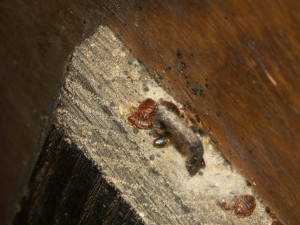So You Think You Want to Control Bed Bugs on Your Own
By Chris Williams on December 30, 2014.
“Bed bugs are best treated by an experienced professional. Let me say that again…If you have bed bugs, and you can hire a professional who knows what they’re doing, then do it. It can save you much grief and lost sleep.”
The expert advice above comes from Mike Merchant, an entomologist and professor at Texas A&M who writes a well-respected national pest blog. You’ve heard me, and others in the pest management industry, say that bed bugs are generally an exception when it comes to do-it-yourself pest control. Why is that?
Why DIY for Bed Bugs is Not a Good Idea
Bed bugs are extremely difficult to find because they hide in cracks and crevices, in bed frames, in dressers, behind baseboards, etc. Even if you can find bed bugs, can you find their hidden eggs? The eggs are resistant to insecticides and hatch days or even weeks after treatment. Even professional exterminators don’t expect to eliminate an established bed bug infestation in a single visit (see How Do Professionals Control Bed Bugs?).
Also, it is generally accepted that while you can eliminate many indoor pests with non-insecticide methods, it is practically impossible to eliminate an established bed bug infestation without some use of insecticides. That knowledge is complicated by the fact that bed bugs have become resistant to most of the insecticides used against them.
So, DIY is not a good idea. However, Merchant and those of us in the pest control business understand that not everyone can afford to hire an exterminator. Or, maybe you’re just stubborn and an avowed DIY kind of person. Merchant offers some tips for those who want to, or have to, do their own bed bug control.
If You Must Try to Control Bed Bugs on Your Own
Determine which rooms are infested
If you’re lucky, the infestation is limited to a single bedroom. Wait too long, and the bed bugs will invade other rooms as well, making control even more difficult.
Don’t throw your bed away
Throwing out an infested mattress or box spring doesn’t do anything except spread the bed bug infestation to others (see Don’t Discard Bed Bug-Infested Furniture). Chances are that a new mattress or bed that you bring in will soon become infested with bed bugs as well, if the premises are not treated.
Don’t move your sleeping area
Moving your bed or just moving yourself to another room for the night will only spread bed bugs into other parts of your home.
Make your bed a safe place to sleep
First, vacuum your mattress and box spring. Then, enclose the mattress and box spring in bed bug-proof, zippered encasements (see Do Mattress Encasements for Bed Bugs Really Work?). Next, treat the frame and headboard with insecticide. Finally, isolate your bed by installing a bed bug interceptor under each leg.
The above just covers the bed area of your home. You also need to inspect and treat all other areas of your home, including furniture. You need to wash and dry washable items and bag other items for isolation, or treatment with heat or cold. Then you need to track your success over time, and very probably you will have to repeat all of this over again, at least once.
For more detail on how to do your own bed bug exterminating, see Merchant’s fact sheet, Bed bugs: Do-it-yourself control options. If, after reading the fact sheet, you decide not to try to get rid of bed bugs on your own, or if you’ve tried and failed, give Colonial Pest a call today.
Photo credit: louento.pix / CC BY-ND
Stay up-to-date with Colonial Pest’s email newsletter!
